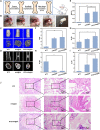A bifunctional bortezomib-loaded porous nano-hydroxyapatite/alginate scaffold for simultaneous tumor inhibition and bone regeneration
- PMID: 37264410
- PMCID: PMC10236870
- DOI: 10.1186/s12951-023-01940-0
A bifunctional bortezomib-loaded porous nano-hydroxyapatite/alginate scaffold for simultaneous tumor inhibition and bone regeneration
Abstract
Treatments of osteolytic lesions due to malignant metastasis remain one of the major clinical challenges. The residual tumor cells after surgical resections and an acidic tumor microenvironment are unfavorable for osteogenic induction. Bortezomib (BTZ), a proteasome inhibitor used in chemotherapy, also has an osteogenic potential in concentration- and Ca2+-dependent manners. In this study, controlled delivery of BTZ in a novel bifunctional scaffold based on nano-hydroxyapatite (nHA) and sodium alginate (SA) nanocomposite, namely BTZ/nHA@SA, has been explored. By smartly adjusting microenvironments, a sustainable release of Ca2+ from nHA could be achieved, which was not only able to cross-link SA but also to regulate the switch between the dual functions of tumor inhibition and bone regeneration of BTZ to promote the osteogenic pathway. The freeze-dried BTZ/nHA@SA scaffold has excellent interconnectivity, is capable to promote the attachment and proliferation of mouse embryonic osteoblast precursor cells, as well as effectively induces breast cancer cell death in vitro. Furthermore, in vivo, studies using a mouse tumor model and a rabbit femoral defect model showed that the BTZ/nHA@SA scaffold could promote tumor ablation, and also enhance bone repair. Therefore, the BTZ/nHA@SA scaffold has unique dual functions of inhibiting tumor recurrence and promoting bone tissue regeneration simultaneously. This smart bi-functional scaffold offers a promising novel approach for oncological treatments by synchronously orchestrating tumor inhibition and tissue regeneration for the repair of neoplastic bone defects.
Keywords: Anti-tumor; BTZ; BTZ/nHA@SA scaffold; Bone regeneration; nHA.
© 2023. The Author(s).
Conflict of interest statement
The authors declare no competing financial interest.
Figures





Similar articles
-
Icariin-loaded porous scaffolds for bone regeneration through the regulation of the coupling process of osteogenesis and osteoclastic activity.Int J Nanomedicine. 2019 Aug 1;14:6019-6033. doi: 10.2147/IJN.S203859. eCollection 2019. Int J Nanomedicine. 2019. PMID: 31534334 Free PMC article.
-
A Naringin-loaded gelatin-microsphere/nano-hydroxyapatite/silk fibroin composite scaffold promoted healing of critical-size vertebral defects in ovariectomised rat.Int J Biol Macromol. 2021 Dec 15;193(Pt A):510-518. doi: 10.1016/j.ijbiomac.2021.10.036. Epub 2021 Oct 25. Int J Biol Macromol. 2021. PMID: 34710477
-
Construction of Vascularized Tissue Engineered Bone with nHA-Coated BCP Bioceramics Loaded with Peripheral Blood-Derived MSC and EPC to Repair Large Segmental Femoral Bone Defect.ACS Appl Mater Interfaces. 2023 Jan 11;15(1):249-264. doi: 10.1021/acsami.2c15000. Epub 2022 Dec 22. ACS Appl Mater Interfaces. 2023. PMID: 36548196
-
Nano-hydroxyapatite structures for bone regenerative medicine: Cell-material interaction.Bone. 2024 Feb;179:116956. doi: 10.1016/j.bone.2023.116956. Epub 2023 Nov 10. Bone. 2024. PMID: 37951520 Review.
-
Nano-Hydroxyapatite as a Delivery System for Promoting Bone Regeneration In Vivo: A Systematic Review.Nanomaterials (Basel). 2021 Sep 29;11(10):2569. doi: 10.3390/nano11102569. Nanomaterials (Basel). 2021. PMID: 34685010 Free PMC article. Review.
Cited by
-
Nano-Topographically Guided, Biomineralized, 3D-Printed Polycaprolactone Scaffolds with Urine-Derived Stem Cells for Promoting Bone Regeneration.Pharmaceutics. 2024 Jan 31;16(2):204. doi: 10.3390/pharmaceutics16020204. Pharmaceutics. 2024. PMID: 38399258 Free PMC article.
-
Nanoparticles and bone microenvironment: a comprehensive review for malignant bone tumor diagnosis and treatment.Mol Cancer. 2024 Nov 1;23(1):246. doi: 10.1186/s12943-024-02161-1. Mol Cancer. 2024. PMID: 39487487 Free PMC article. Review.
-
Bortezomib-releasing silica-collagen xerogels for local treatment of osteolytic bone- and minimal residual disease in multiple myeloma.J Hematol Oncol. 2024 Dec 18;17(1):128. doi: 10.1186/s13045-024-01636-4. J Hematol Oncol. 2024. PMID: 39695697 Free PMC article.
-
Advancements in nanohydroxyapatite: synthesis, biomedical applications and composite developments.Regen Biomater. 2024 Nov 5;12:rbae129. doi: 10.1093/rb/rbae129. eCollection 2025. Regen Biomater. 2024. PMID: 39776858 Free PMC article. Review.
References
-
- Yuan J, Ye Z, Zeng Y, Pan Z, Feng Z, Bao Y, Li Y, Liu X, He Y, Feng Q. Bifunctional scaffolds for tumor therapy and bone regeneration: synergistic effect and interplay between therapeutic agents and scaffold materials. Mater Today Bio. 2022;15:100318. doi: 10.1016/j.mtbio.2022.100318. - DOI - PMC - PubMed
-
- He C, Yu LD, Hao YQ. Combinatorial photothermal 3D-printing scaffold and checkpoint blockade inhibits growth/metastasis of breast cancer to bone and accelerates osteogenesis. Adv Funct Mater. 2021;31(10):2006214. doi: 10.1002/adfm.202006214. - DOI
-
- Han W, El Botty R, Montaudon E, Malaquin L, Deschaseaux F, Espagnolle N, Marangoni E, Cottu P, Zalcman G, Parrini MC, Assayag F, Sensebe L, Silberzan P, Vincent-Salomon A, Dutertre G, Roman-Roman S, Descroix S, Camonis J. In vitro bone metastasis dwelling in a 3D bioengineered niche. Biomaterials. 2021;269:120624. doi: 10.1016/j.biomaterials.2020.120624. - DOI - PubMed
MeSH terms
Substances
Grants and funding
LinkOut - more resources
Full Text Sources
Miscellaneous

